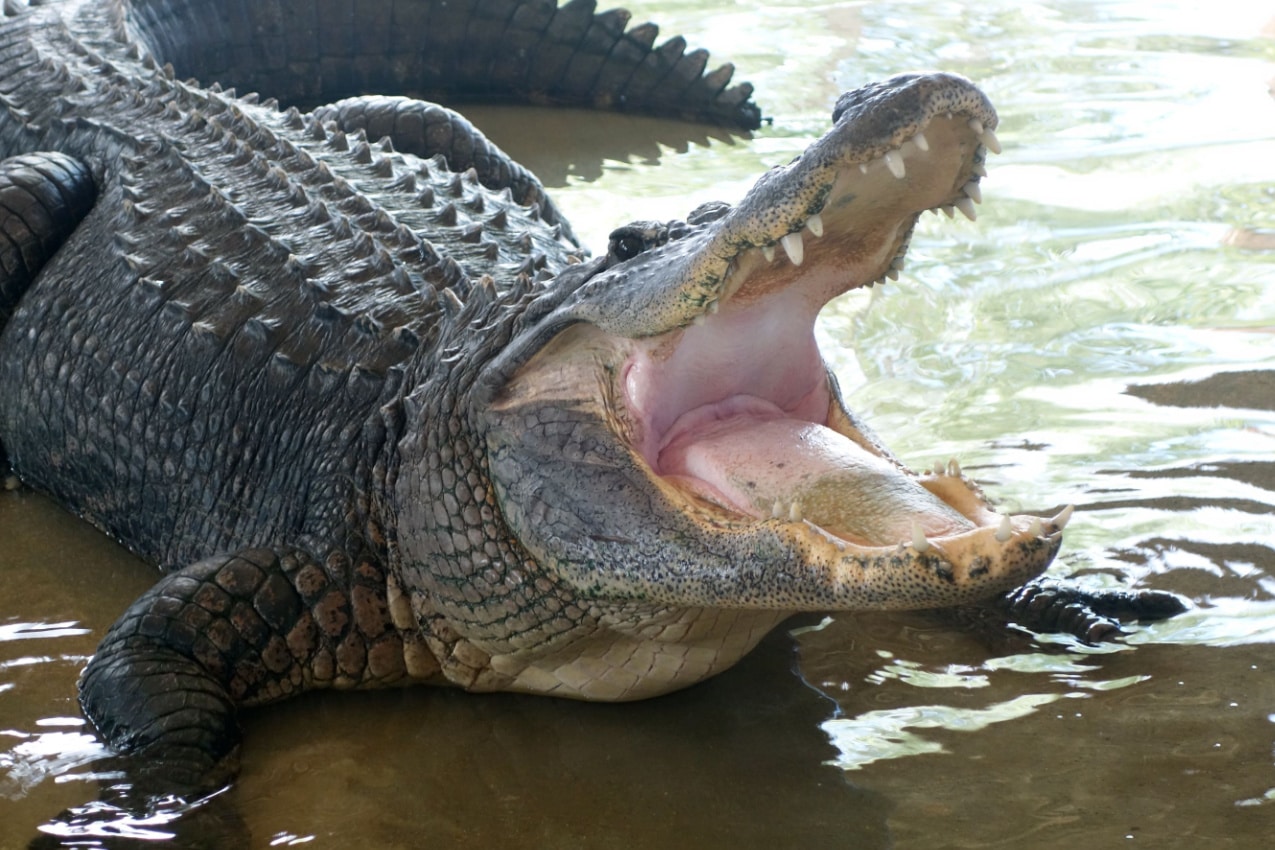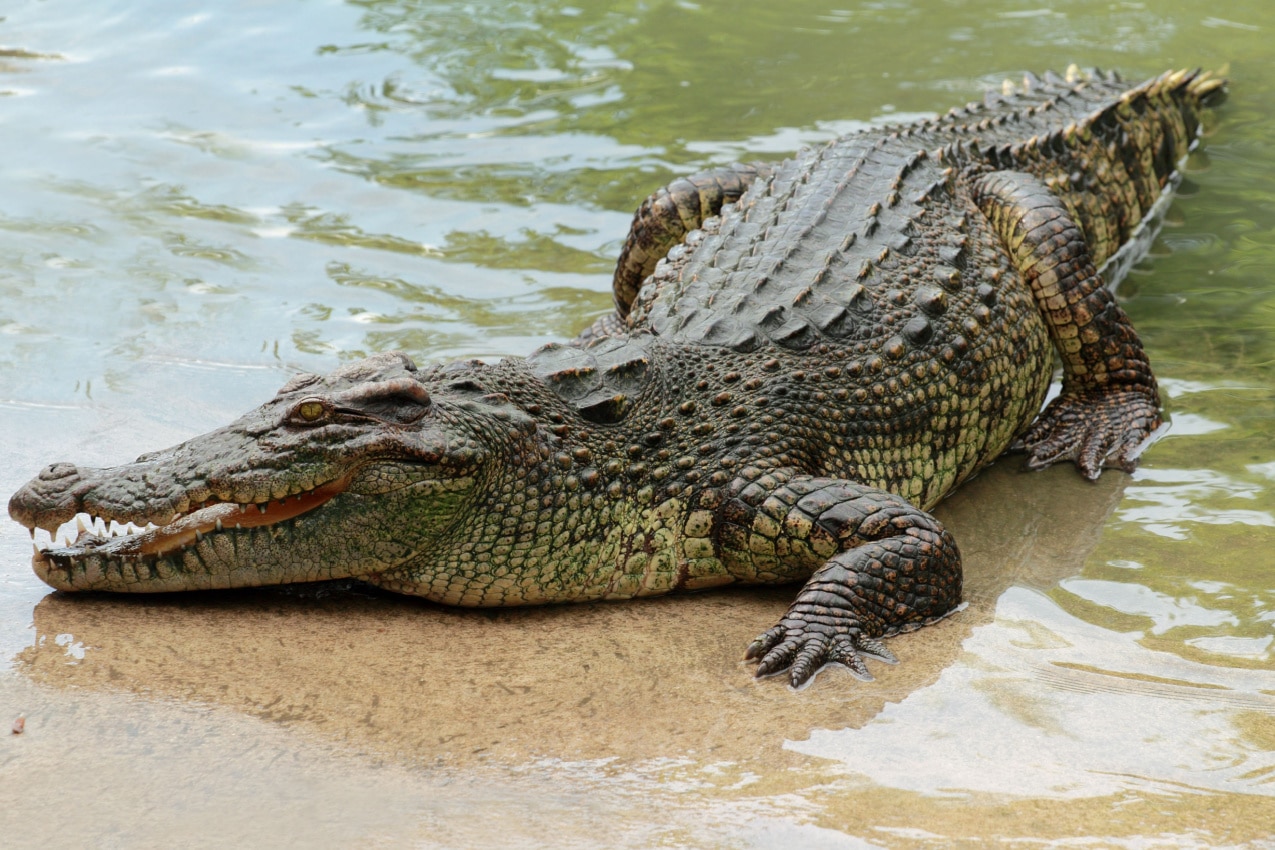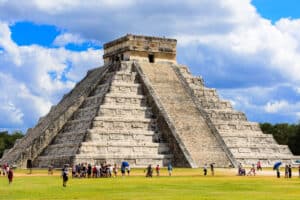Do alligators exist in Mexico? ¡Claro que sí!
Mexico isn’t only home to alligators but also its cousin — crocodiles.
Today we’ll share all there is to know about these scary predators, plus some tips and tricks on how to salsa your way out of harm if you see them in the wild.
Let’s cha-cha through the wild world of alligators and crocodiles in Mexico. We’re in for a reptile-tastic time!
Alligators in Mexico: The Reptiles That Govern Mexico’s Wetlands
Only two species of alligators still exist in the world — the rest of them have sadly gone extinct.
The last species standing are the American alligator and the Chinese alligator. Their scientific names are alligator mississippiensis and alligator sinensis.
So which one lives in Mexico? You probably guessed it — the American alligator. It can be found in the Gulf Coast Prairies and the Mexican Marshes.

The name “alligator” comes from the Spanish “el lagarto,” meaning “the lizard,” which is somewhat ironic as these creatures are definitely not lizard-sized.
The average size of an adult male American gator is 11.2ft (3.4m), whereas a female is 8.2ft (2.6m). American alligators can reach a weight of about half a ton (1,000lb/454kg).
Alligators thrive in warmer climes, in temperatures ranging from 82°F to 92°F (27°C to 33°C), which makes Mexico the perfect home for them.
Their territories are the savannah, the shrublands, and the grasslands, and the chances of encountering one outside of this area is very low.
However, if you visit the Mexican Marshes and Gulf Coast Prairies, exercise extreme caution and avoid getting too close to the water’s surface. These areas are basically swamps covered in lush greenery, which makes it super challenging to see the alligators lurking beneath the surface.
In these areas, many other wild animals can also make your blood freeze, like deadly snakes and the alligators’ cousins — crocodiles.
Crocodiles: Mexico’s Ancient Predators

As their name suggests, American alligators aren’t native to Mexico, they are native to the USA.
However, because Mexico borders Texas, the base point for alligators, they like to cross the border to the Mexican wetlands.
But guess who are the native reptiles of Mexico? The crocodiles.
There are 14 species of crocodiles in the world, and three of them roam around in the wild waters of Mexico. The Mexican species include the Morelet crocodile, the American crocodile, and the Spectacled Caiman crocodile.
Their scientific names are crocodylus moreletii, crocodylus acutus, and caiman crocodilus, respectively.
Crocodiles prefer freshwater habitats, which is why you can find them in the Mexican Marshes and Gulf Coast Prairies alongside alligators. But what’s different about them is they also thrive in saltwater, specifically around the coastal areas of the Pacific Ocean and the Caribbean Sea.
The name “crocodile” comes from the Greek word “krokódeilos,” which is a mixture of two words: “kroké” means “stone,” and “deilos” means “reptile.” Kudos to the Greeks; they certainly put much more thought into naming these reptiles than the Spanish.
Crocodiles are somewhat bigger than gators. The biggest species is the American crocodile, with adult males measuring up to 20ft (6m) and females up to 12ft (3.6m). They’re also the heaviest and can weigh up to a ton (2,000lb/907kg).
Morelet’s crocodile comes second, with adult males measuring up to 10ft (3m) and females around 7ft (2m). Their weight can reach as high as 220lb (100kg). These are the closest species to the American alligators, but only in size, as gators tend to weigh way more than Morelet crocodiles.
The spectacled caiman crocodile is the smallest species of the group. When compared to the massive American crocodile, these species look like toys! The adult males reach lengths of up to 8ft (2.4m), whereas the female ones measure about 4.5ft (1.4m). They can weigh up to 220lb (100kg).
Regardless of size, crocodiles outnumber alligators in Mexico — they are, after all, natives to these lands. However, both reptiles look very similar, and many crocodile encounters are actually mistaken for alligator encounters in Mexico. So let’s learn how to differentiate between the two.
Alligators vs. Crocodiles: Their Snap-Tastic Differences
Alligators and crocodiles aren’t animals you can casually walk up to, observe up close, and say, “A-ha! This one’s a gator!”
Instead, many sightings are from afar, making it somewhat difficult to differentiate between the two, especially if you have an inexperienced eye.
So, how can you tell if what you’ve spotted in Mexico’s untamed waters is a crocodile or an alligator? Well, if it speaks Spanish, it’s probably a crocodile. Just kidding!
First things first, pay attention to the snout. Crocodile snouts are long and pointy, whereas those of alligators are broader and rounder.
Notice the color of their skin next. Usually, crocodiles have earthy tones, so their skin will be olive green or gray. Alligators, on the other hand, are a deeper, blackish-gray color.
Their teeth look different too. Crocs’ teeth are more pointed and sharp, while alligators’ teeth are more cone-shaped. When their jaws are closed, the upper and lower teeth of a crocodile are both visible. It almost looks like the reptile is smirking. As for gators, you can only see their top-row teeth.
Crocodiles have a greater bite force than gators. Their bite force is approximately 3,700 PSI (pounds per square inch), whereas the alligator’s bite force is approximately 2,000 PSI. For context, humans use a bite force of only 150 to 200 PSI to eat meat.
Alligators can’t tolerate saltwater, so you can only find them in swampy regions, lakes, and rivers. Crocodiles, on the other hand, can call every body of water in Mexico their home, like the true natives they are. You may not only see them in the wetlands, but also in the Pacific, in the Gulf, and in Caribbean salt waters!
And last but not least, their temper. Both reptiles are vicious, but crocodiles are more dangerous when they detect prey. They’ll attack anything that catches their attention, whether it’s a human or another animal. Alligators can strike if threatened; otherwise, they’ll just observe the situation and flee.
According to some sources, Florida has had over 400 unprovoked alligator bite incidents in the last 70 years, with only 26 having a fatal outcome. Crocodiles, on the other hand, kill 1,000 people each year in Africa.
Now, let’s head down to Mexico again. Are reptile incidents frequent there?
Reptilian Encounters in Mexico: Latest Incidents
Tourists expect to have unforgettable adventures when visiting Mexico, And for good reason: this is a land of rich culture and tradition, breathtaking nature, delectable cuisine, and some of the world’s best beaches.
However, Mexico is also a place where encounters with wild animals are frequent — some of the animals in question are cute, like the Manatee, while others are potentially lethal, like sharks, crocodiles, and alligators.
So, let’s talk about reptile encounters in particular. We’ll start with alligators, as they’re the friendlier of the two big reptiles you can find in Mexico.
We couldn’t find any reports of alligator incidents in Mexico. They seem to be well-behaved tourists, coming to chill in the wetlands and soak up the beautiful Mexican sun. Plus, as we already mentioned, they aren’t as spread out as crocodiles are, so the chances of you spotting one would be high only if you take a boat ride to the wetlands.
What you need to be on the lookout for while in Mexico are crocodiles because they like to roam around everywhere, especially in Mexico’s coastal hotspots.
One such beach encounter was recorded by a tourist on a beach in Cozumel, but luckily, the crocodile was uninterested in the tourists and went straight into the ocean.
Not every crocodile, however, will be as nonchalant as that one was. In fact, the vast majority of crocodiles attack immediately. One such horrible incident happened to two U.S. tourists in Puerto Vallarta after a night swim on the Bocanegra beach. Fortunately, both men survived but were severely hurt — one was injured on his legs, right arm, torso, and stomach, whereas the other suffered injuries to his right arm and groin.
Another attempt for a late-night swim ended tragically in Puerto Vallarta when a crocodile grabbed an 18-year-old woman by the leg and pulled her into the water. Fortunately, a staff member at the hotel was able to hit the crocodile with a piece of wood, forcing it to release its victim. The woman was taken to the hospital, sustaining severe muscle and tendon damage in her right leg.
Unfortunately, crocodile attacks aren’t limited to Puerto Vallarta, as reports have also been filed from other popular beaches around the Mexican coast. In Cancun, for example, a 12-year-old boy was bitten. In Tamaulipas, a man suffered an injury from a massive crocodile after jumping into the Carpintero Lagoon. In the same spot, a crocodile was captured on camera swimming around with a human corpse.
Yes, Mexico’s reptiles are a force to be reckoned with, and these incidents attest to the fact that crocodile encounters aren’t as rare as one might believe. On the contrary, crocodiles are prevalent, and people must exercise extreme caution when choosing where to swim.
Tips & Tricks for Croc & Gator Safety in Mexico
When in Mexico, safety comes first. So, before you book a trip there, let’s learn some tips and tricks to outsmart those snappy reptilians.
What to Do if You Encounter an Alligator or a Crocodile in Mexico?
If you see these reptiles on land, remain quiet and cautiously walk away. By no means should you try and approach the animal. If the reptile charges at you, turn around and run as fast as possible. These reptiles are heavy and can’t run very long on land — you have good chances of outrunning them.
If you fall into the waters where alligators or crocodiles swim, resist the impulse to splash around. Those quick-witted reptiles are on the lookout for anything that moves, and splashing is like ringing the dinner bell for them! We understand that staying calm in such a situation is difficult, yet it may be the key to your survival. Swim slowly and softly to the safety of the shore, keeping your hands below the water’s surface to avoid getting their attention.
What to Do if You Get Attacked by an Alligator or Crocodile?
Let’s hope you never experience this, but nevertheless, it’s wise to know what to do in a worst-case scenario.
Remember this, if a reptile bites you and lets go, it’s a defensive attack. There is no time to be a hero in this situation! Get away from it immediately. However, if the reptile gets a full grip on you and doesn’t let go, don’t give up — use all your energy to fight it off. Here are some tips.
To begin, aim for the reptile’s eyes. They’re their weak spot, so poke them with whatever you can get your hands on — sticks, stones, anything goes.
If you can’t get to their eyes, another vulnerable area is their palatal valve. The valve is located at the back of their mouths and acts as a barrier, preventing water from entering their mouths and drowning them. If the animal tries to pull you underwater, hitting and grabbing this valve may be your only shot at survival. Once you reach the valve, pull it downwards, and water will enter its throat, forcing the reptile to release you.
Your best bet is to throw as many punches as possible. If there are people nearby, they can take whatever is available, a stick, a rock, a branch, and strike the reptile’s head.
If you manage to release your body from the animal’s hold, seek medical assistance immediately. Not only will the bite cause blood loss, but the wound will quickly get infected thanks to the large number of bacteria inside the reptile’s mouth.
Other Safety Tips
- Maintain your distance and stay at least 82ft (25m) away from reptiles. If you’re in a boat, the minimum safe distance for boats should be around 33ft (10m).
- Avoid standing or leaning over water while alligators or crocodiles are nearby or known to roam the area. These reptiles can propel themselves vertically out of the water with the help of their tail.
- Never go near a crocodile or alligator’s nest. Mothers will guard their youngsters against people fiercely.
- Alligators and crocodiles should not be fed. While it may appear to be an exciting adventure, it’s a big no-no in the reptile world because they’ll start to correlate humans with food.
- Keep an eye on your kids and pets. Crocodiles and alligators prefer to hunt smaller prey. Keep your loved ones as far away from the water’s edge as possible.
- Be extra cautious near murky water. When preying on something, these reptiles sink their entire bodies underwater, with only their eyes and nostrils on the surface, making them unnoticeable.
- Crocodiles and alligators do most of their hunting at night. If you know you are around infested waters, never swim at nightfall, and be cautious during the day.
- If you see a sign that says “Beware of Gators and Crocodiles,” you should respect it and stay away.
Conclusion
Which one makes your bones tremble more — a gator or a crocodile?
For us, the alligator looks more terrifying. It has almost blackish skin and a much larger snout, giving it the appearance of a reptile Godzilla!
However, if we were traveling to Mexico, we would be on the lookout for crocodiles, which are colossal death machines that may lurk anywhere, from the wetlands to the ocean. So be smart, ask around, and keep an eye out for any signs of our reptilian neighbors. Safe adventures, amigos!



